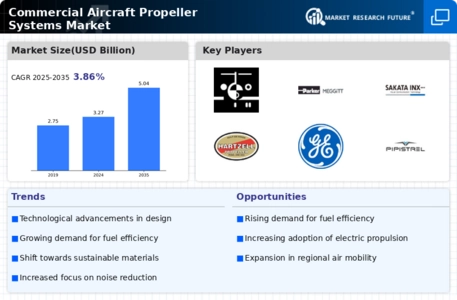Top Industry Leaders in the Commercial Aircraft Propeller Systems Market
 Key Players:
Key Players:Hartzell Propeller Inc (US)
Mt-Propeller (Germany)
Dowty Propellers (UK)
Mccauley Propeller (US)
Airmaster Propellers (New Zealand)
Hélices E-Props (France)
Fp Propeller (Italy)
Ratier-Figeac (France)
Whirlwind Propellers (California)
Sensenich Propeller (US)
Hercules Propellers (UK)
and Aerosila (Russia).
Strategies Adopted: To maintain their competitive edge, key players in the market have adopted diverse strategies. Technological innovation is a cornerstone, with continuous research and development aimed at enhancing propeller efficiency, reducing weight, and improving overall performance. Collaborations and partnerships with aircraft manufacturers have also become common, enabling seamless integration of propeller systems into new aircraft designs. Moreover, a strategic focus on sustainability has become increasingly prevalent, aligning with the aviation industry's broader goals of reducing environmental impact.
Factors for Market Share Analysis: Market share analysis in the Commercial Aircraft Propeller Systems segment is influenced by several factors. Product performance and reliability play a crucial role, as airlines and manufacturers seek systems that enhance fuel efficiency and minimize maintenance costs. Pricing strategies, customer service, and aftermarket support also contribute significantly to market share dynamics. Additionally, regulatory compliance and adherence to industry standards are vital considerations, ensuring that propeller systems meet stringent safety and environmental requirements.
New and Emerging Companies: The market landscape is witnessing the entry of new and emerging companies that bring fresh perspectives and innovative solutions. Emerging players such as MT-Propeller and Culver Props are gaining traction, leveraging advanced materials and novel design approaches. These companies often target niche markets or focus on specific aircraft segments, providing specialized solutions that cater to evolving industry demands.
Industry News: Recent developments in the Commercial Aircraft Propeller Systems market include breakthroughs in materials science, with the introduction of lightweight yet durable materials for propeller blades. Advancements in digital technology, such as smart sensors and data analytics, are enhancing propeller monitoring and predictive maintenance capabilities. Furthermore, industry collaborations to develop hybrid-electric propulsion systems are gaining attention, reflecting the broader trend toward sustainable aviation.
Current Company Investment Trends: Investment trends in the Commercial Aircraft Propeller Systems market reveal a strategic emphasis on technology development and expansion. Key players are allocating substantial resources to research and development, aiming to stay at the forefront of innovation. Mergers and acquisitions are also prevalent, with companies seeking to enhance their market presence by integrating complementary technologies or acquiring niche expertise. Furthermore, investments in sustainable aviation solutions, including biofuels and electric propulsion, underscore the industry's commitment to environmental responsibility.
Overall Competitive Scenario: The overall competitive scenario in the Commercial Aircraft Propeller Systems market is characterized by a balance between established players, striving to maintain dominance through continuous innovation and global reach, and nimble, emerging companies disrupting the status quo with novel approaches and specialized offerings. Collaboration and partnerships are fostering synergies, enabling the development of integrated propulsion solutions that meet the evolving needs of the aviation industry.
As the Commercial Aircraft Propeller Systems market continues to evolve, the competitive landscape reflects a dynamic interplay of innovation, strategic partnerships, and a commitment to sustainability. Established players face the challenge of adapting to emerging technologies and market trends, while new entrants seize opportunities in niche segments. The industry's collective focus on fuel efficiency, performance optimization, and environmental responsibility is steering the market toward a future marked by cutting-edge propulsion solutions and sustainable aviation practices.
Recent News :
Hartzell Propeller:
- October 26, 2023: Received FAA certification for its new lightweight, composite propeller blades for the ATR 42-600 turboprop aircraft. This offers airlines improved fuel efficiency and performance.
- June 22, 2023: Announced a partnership with magnix to collaborate on electric propulsion systems for smaller regional aircraft. This potentially positions Hartzell for the future of hybrid and electric aviation.
MT-Propeller:
- December 15, 2023: Secured a contract with De Havilland Canada to supply its MTV-19 props for the Dash 8-400 freighter aircraft. This expands MT-Propeller's presence in the cargo market.
- September 20, 2023: Launched its new MTV-8 prop for single-engine turboprop aircraft, offering increased climb performance and payload capacity. This caters to niche segments within the market.
Pratt & Whitney:
-
November 9, 2023: announced significant advancements in its hybrid-electric PW150G engine program, demonstrating successful ground and taxi tests. This marks a big step toward hybrid propulsion for commercial aircraft.


